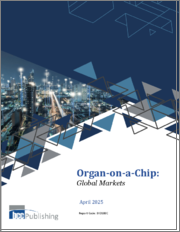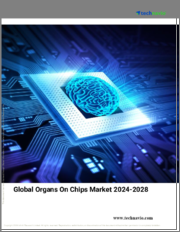
|
시장보고서
상품코드
1447615
장기 온칩 시장 : 유형, 재료, 모델 유형, 용도, 최종사용자, 세계 예측(2024-2032년)Organs-on-chips Market-Type [Product (Liver, Lung, Heart, Kidney), Service], Material (PDMS, Polymer, Glass), Model Type (Single, Multi-organ), Application (Drug Discovery, Toxicity Testing, Personalized Medicine), End-user, Global Forecast 2024-2032 |
||||||
세계의 장기 온칩 시장은 동물 실험을 대신하는 것에 대한 수요의 증가, 기술의 진보, 연구개발에 대한 투자의 증가 등을 배경으로 2024-2032년의 CAGR이 32.2%를 넘을 것으로 예측됩니다.
PETA에 따르면 영국에서는 약 7,600만 건의 동물 실험이 이루어지고 있습니다. 조직이 이 수치를 줄이고 동물 실험에 대한 의존도를 최소화하는 것을 목표로 하고 있으므로 시장은 성장할 것으로 예상됩니다. 장기 온칩은 인간 장기의 생리적, 기계적 특성을 모방할 수 있는 유망한 플랫폼을 제공하기 때문에 의약품 개발, 독성 테스트 및 질병 모델링에 혁명을 가져올 수 있습니다.
장기 온칩 시장은 유형, 재료, 모델 유형, 애플리케이션, 최종사용자 및 지역별로 분류됩니다.
고분자 재료 부문은 다용도성, 생체 적합성, 조정 가능한 특성으로 인해 2024-2032년 강력한 CAGR을 기록할 것으로 예측됩니다. 폴리디메틸실록산(PDMS) 및 폴리우레탄과 같은 폴리머는 인체 조직의 미세 환경을 효과적으로 재현할 수 있으므로 장기 온칩 제조를 위한 일반적인 선택으로 부상하고 있습니다. 또한 소프트 리소그래피와 마이크로플루이딕스공학을 포함한 고분자 제조 기술의 발전은 제약 및 생명공학 산업 전반에 걸쳐 고분자 기반 장기 온칩 플랫폼의 채택을 더욱 촉진하고 있습니다.
독성 테스트 용도는 기존 동물 실험보다 더 정확하고 예측 가능한 대안을 제공함으로써 2032년까지 막대한 매출을 창출할 것으로 예상됩니다. 이러한 마이크로플루이딕스 장비를 통해 연구자들은 약물, 화학물질, 인체 조직 간의 복잡한 상호작용을 시뮬레이션할 수 있으며, 잠재적인 독성 문제를 조기에 발견하고 동물 모델에 대한 의존도를 최소화할 수 있습니다. 전 세계 규제기관들이 의약품 개발에서 동물 실험의 감소와 대체를 강조하고 있으며, 독성 테스트를 위한 장기 온칩에 대한 수요는 향후 수년간 급증할 것으로 예상됩니다.
유럽의 장기 온칩 시장 규모는 주요 제약사, 학술연구 기관 및 지원적인 규제 프레임워크의 존재로 인해 2032년까지 크게 확대될 것으로 예상됩니다. 영국, 독일, 프랑스는 연구 및 상업화 노력을 가속화하기 위해 많은 투자를 하고 있습니다. 또한 유럽의약품청(EMA)과 같은 규제기관이 대체 테스트 방법의 채택을 촉진하는 구상을 취함으로써 이 지역 전체에서 장기 온칩 플랫폼의 광범위한 수용을 촉진하고 있습니다.
목차
제1장 조사 방법과 조사 범위
제2장 주요 요약
제3장 업계 인사이트
- 에코시스템 분석
- 업계에 대한 영향요인
- 촉진요인
- 만성질환의 증가
- 맞춤형 의료에 대한 수요의 증가
- 장기 온칩 기술의 진보
- 바이오메디컬 애플리케이션에서 장기 온칩 모델의 이용 확대
- 업계의 잠재적 리스크 & 과제
- 장기 온칩 기술 도입에서의 과제와 복잡성
- 규제상 장애
- 촉진요인
- 성장 가능성 분석
- 규제 상황
- Porter의 산업 분석
- PESTEL 분석
제4장 경쟁 구도
- 서론
- 기업 매트릭스 분석
- 주요 시장 기업의 경쟁 분석
- 경쟁 포지셔닝 매트릭스
- 전략 대시보드
제5장 시장 추산·예측 : 유형별, 2018-2032년
- 주요 동향
- 제품
- 간 온칩
- 폐 온칩
- 심장 온칩
- 신장 온칩
- 기타 제품
- 서비스
제6장 시장 추산·예측 : 재료별, 2018-2032년
- 주요 동향
- 폴리디메틸실록산(PDMS)
- 폴리머
- 유리
제7장 시장 추산·예측 : 모델 유형별, 2018-2032년
- 주요 동향
- 단일 장기 모델
- 다장기 모델
제8장 시장 추산·예측 : 용도별, 2018-2032년
- 주요 동향
- Drug Discovery
- 독성 시험
- 질환 모델링
- 맞춤형 의료
- 기타 용도
제9장 시장 추산·예측 : 최종사용자별, 2018-2032년
- 주요 동향
- 제약·바이오테크놀러지 기업
- 학술·연구기관
- 기타 최종사용자
제10장 추산·예측 : 지역별, 2018-2032년
- 주요 동향
- 북미
- 미국
- 캐나다
- 유럽
- 독일
- 영국
- 프랑스
- 스페인
- 이탈리아
- 기타 유럽
- 아시아태평양
- 중국
- 일본
- 인도
- 호주
- 기타 아시아태평양
- 라틴아메리카
- 브라질
- 멕시코
- 기타 라틴아메리카
- 중동 및 아프리카
- 남아프리카공화국
- 사우디아라비아
- 기타 중동 및 아프리카
제11장 기업 개요
- Altis Biosystems
- AlveoliX AG
- Axosim
- Bi/ond Solutions B.V
- Cherry Biotech
- CN-Bio
- Emulate, Inc.
- Hesperos, Inc.
- Insphero
- MesoBioTech
- Mimetas B.V.
- Nortis Inc.
- React4Life
- TARA Biosystems(Valo Health)
- TissUse GmbH
The global organs-on-chips market is anticipated to witness more than 32.2% CAGR from 2024 to 2032 driven by the increasing demand for alternatives to animal testing, advancements in technology, and rising investments in R&D.
According to PETA, nearly 76 million procedures are done on animals across the UK. As organizations aim to reduce this number and minimize the dependency on animal testing, the market is anticipated to grow. As organs-on-chips offer a promising platform for mimicking the physiological and mechanical properties of human organs, thus helping in revolutionizing drug development, toxicity testing, and disease modeling.
The organs-on-chips market is classified based on type, material, model type, application, end-user, and region.
The polymer material segment is predicted to record strong CAGR from 2024 to 2032, owing to its versatility, biocompatibility, and tunable properties. Polymers such as polydimethylsiloxane (PDMS) and polyurethane have emerged as popular choices for manufacturing organs-on-chips due to their ability to replicate the microenvironment of human tissues effectively. Moreover, advancements in polymer fabrication techniques, including soft lithography and microfluidics, are further fueling the adoption of polymer-based organs-on-chips platforms across pharmaceutical and biotechnology industries.
The toxicity testing application segment is expected to generate massive revenue by 2032 as they offer a more accurate and predictive alternative to traditional animal testing methods. These microfluidic devices enable researchers to simulate the complex interactions between drugs, chemicals, and human tissues, thereby facilitating early detection of potential toxicity issues and minimizing the reliance on animal models. With regulatory agencies worldwide emphasizing the reduction and replacement of animal testing in drug development, the demand for organs-on-chips for toxicity testing is expected to surge in the coming years.
Europe organs-on-chips market size will expand significantly through 2032 driven by the presence of leading pharmaceutical companies, academic research institutes, and supportive regulatory frameworks. United Kingdom, Germany, and France are significantly investing to accelerate research and commercialization efforts. Additionally, initiatives by regulatory bodies such as the European Medicines Agency (EMA) to promote the adoption of alternative testing methods are fostering the widespread acceptance of organs-on-chips platforms across the region.
Table of Contents
Chapter 1 Methodology & Scope
- 1.1 Market definition
- 1.2 Base estimates & calculations
- 1.3 Forecast calculation
- 1.4 Data validation
- 1.5 Data sources
- 1.5.1 Primary
- 1.5.2 Secondary
- 1.5.2.1 Paid sources
- 1.5.2.2 Public sources
Chapter 2 Executive Summary
- 2.1 Industry 360 degree synopsis
Chapter 3 Industry Insights
- 3.1 Industry ecosystem analysis
- 3.2 Industry impact forces
- 3.2.1 Growth drivers
- 3.2.1.1 Increasing prevalence of chronic disease
- 3.2.1.2 Increasing demand for personalized medicine
- 3.2.1.3 Growing advancement in organ-on-chip technology
- 3.2.1.4 Expanding use of organ-on-chip models in biomedical applications
- 3.2.2 Industry pitfalls & challenges
- 3.2.2.1 Challenges and intricacies in implementing organ-on-chip techniques
- 3.2.2.2 Regulatory obstacles
- 3.2.1 Growth drivers
- 3.3 Growth potential analysis
- 3.4 Regulatory landscape
- 3.5 Porter's analysis
- 3.6 PESTEL analysis
Chapter 4 Competitive Landscape, 2023
- 4.1 Introduction
- 4.2 Company matrix analysis
- 4.3 Competitive analysis of major market players
- 4.4 Competitive positioning matrix
- 4.5 Strategic dashboard
Chapter 5 Market Estimates and Forecast, By Type, 2018 - 2032 ($ Mn)
- 5.1 Key trends
- 5.2 Product
- 5.2.1 Liver-on-chip
- 5.2.2 Lung-on-chip
- 5.2.3 Heart-on-chip
- 5.2.4 Kidney-on-chip
- 5.2.5 Other products
- 5.3 Service
Chapter 6 Market Estimates and Forecast, By Material, 2018 - 2032 ($ Mn)
- 6.1 Key trends
- 6.2 Polydimethylsiloxane (PDMS)
- 6.3 Polymer
- 6.4 Glass
Chapter 7 Market Estimates and Forecast, By Model Type, 2018 - 2032 ($ Mn)
- 7.1 Key trends
- 7.2 Single-organ model
- 7.3 Multi-organ model
Chapter 8 Organ on Chip Market Estimates and Forecast, By Application, 2018 - 2032 ($ Mn)
- 8.1 Key trends
- 8.2 Drug discovery
- 8.3 Toxicity testing
- 8.4 Disease modeling
- 8.5 Personalized medicine
- 8.6 Other applications
Chapter 9 Market Estimates and Forecast, By End-User, 2018 - 2032 (USD Million)
- 9.1 Key trends
- 9.2 Pharmaceutical and biotechnology companies
- 9.3 Academic and research institutes
- 9.4 Other end-users
Chapter 10 Organ on Chip Market Estimates and Forecast, By Region, 2018 - 2032 (USD Million)
- 10.1 Key trends
- 10.2 North America
- 10.2.1 U.S.
- 10.2.2 Canada
- 10.3 Europe
- 10.3.1 Germany
- 10.3.2 UK
- 10.3.3 France
- 10.3.4 Spain
- 10.3.5 Italy
- 10.3.6 Rest of Europe
- 10.4 Asia Pacific
- 10.4.1 China
- 10.4.2 Japan
- 10.4.3 India
- 10.4.4 Australia
- 10.4.5 Rest of Asia Pacific
- 10.5 Latin America
- 10.5.1 Brazil
- 10.5.2 Mexico
- 10.5.3 Rest of Latin America
- 10.6 Middle East and Africa
- 10.6.1 South Africa
- 10.6.2 Saudi Arabia
- 10.6.3 Rest of Middle East and Africa
Chapter 11 Company Profiles
- 11.1 Altis Biosystems
- 11.2 AlveoliX AG
- 11.3 Axosim
- 11.4 Bi/ond Solutions B.V
- 11.5 Cherry Biotech
- 11.6 CN-Bio
- 11.7 Emulate, Inc.
- 11.8 Hesperos, Inc.
- 11.9 Insphero
- 11.10 MesoBioTech
- 11.11 Mimetas B.V.
- 11.12 Nortis Inc.
- 11.13 React4Life
- 11.14 TARA Biosystems (Valo Health)
- 11.15 TissUse GmbH



















